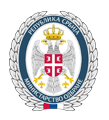08.11.2016.
Exhibition about bombing of Belgrade University in Great War
 It has long been known that barbarity means the destruction of cultural monuments and educational centres. The exhibition about bombing of Captain Miša’s Mansion, which used to be and still is the central building of Belgrade Higher School, then the Lyceum and in the end the University, opened today in the Small Gallery of the Central Military Club showing exactly such a less known detail from the history of the Great War. Emphasizing that this event is a part of series of events by which Media Centre Odbrana marks the centenary of the Great War, Lieutenant Colonel Zoran Krupež, Deputy Head of Media Centre Odbrana, stressed that it was hard to mention everything ruined during the period of great suffering.
It has long been known that barbarity means the destruction of cultural monuments and educational centres. The exhibition about bombing of Captain Miša’s Mansion, which used to be and still is the central building of Belgrade Higher School, then the Lyceum and in the end the University, opened today in the Small Gallery of the Central Military Club showing exactly such a less known detail from the history of the Great War. Emphasizing that this event is a part of series of events by which Media Centre Odbrana marks the centenary of the Great War, Lieutenant Colonel Zoran Krupež, Deputy Head of Media Centre Odbrana, stressed that it was hard to mention everything ruined during the period of great suffering. “The importance of these photographs, which say more than thousand words, is even greater, as well as the whole exhibition, which shows the annihilation of the University at one place”, said Lieutenant Colonel Krupež at the opening.
“The importance of these photographs, which say more than thousand words, is even greater, as well as the whole exhibition, which shows the annihilation of the University at one place”, said Lieutenant Colonel Krupež at the opening.The Director of the Museum of Pedagogy Božidar Zejak explained that the exhibition had been in front of the audience for the third time. He added that annihilation and suffering had long been tradition for Serbian spirituality, giving examples of burning of Saint Sava’s remains on Vračar and the remains of the National Library at Kosančićev Venac.
 Branislava Jordanović from the Museum of Pedagogy, the author of the exhibition, stressed the importance of Đorđe Stanojević, PhD, the rector of the University at that time, regarded as the author of the first artistic photography in Serbia. He noted that Captain Miša’s Mansion, that is the University, as one of the tallest buildings in Belgrade at that time, had been bombed during the first night and that it had been the regular target. He sent the taken photographs to Paris, where they first appeared in the papers “Liberation”, and then they were published in a separate book in 1915 with the assistance of the Director of the Directorate of Education Lucien Poincare, a brother of a famous politician.
Branislava Jordanović from the Museum of Pedagogy, the author of the exhibition, stressed the importance of Đorđe Stanojević, PhD, the rector of the University at that time, regarded as the author of the first artistic photography in Serbia. He noted that Captain Miša’s Mansion, that is the University, as one of the tallest buildings in Belgrade at that time, had been bombed during the first night and that it had been the regular target. He sent the taken photographs to Paris, where they first appeared in the papers “Liberation”, and then they were published in a separate book in 1915 with the assistance of the Director of the Directorate of Education Lucien Poincare, a brother of a famous politician.Vladimir Bumbaširević, the rector of Belgrade University, reminded that there was no country participating in the war which paid greater price for its freedom than Serbia. “Therefore this is a right moment for Belgrade to see this exhibition”, said Bumbaširević.
The exhibition, which can be seen in the Central Military Club until 26th November has been carried out in collaboration with the Museum of Pedagogy, which is the most deserving for research whose outcome is this cultural event and the Faculty of Chemistry, which took out and borrowed the old laboratoty artefacts from its historical collection in order to make the exhibition more complete.




